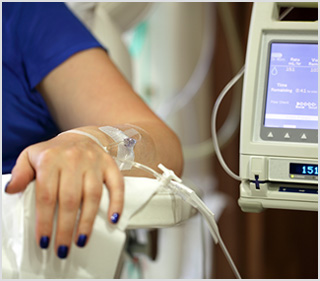Guarding Against Chemotherapy-Associated Blood Clots
Researchers are using genetic tests to help identify breast cancer patients at risk for potentially life-threatening complications of chemotherapy.

Blood clots that develop in the veins of patients – known as venous thromboembolism or VTE – are a serious and potential fatal complication of cancer treatment, particularly chemotherapy. Clots that break off and travel to the lungs or heart are especially dangerous.
And while blood thinners can use used to prevent VTEs, because of the risk of internal bleeding clinicians sometimes try to avoid giving these drugs to patients getting chemotherapy.
A study recently published in Clinical Cancer Research, a journal of the American Association for Cancer Research, suggests that genetic testing could help identify breast cancer patients with high risk of experiencing VTE, allowing clinicians to implement preventative measures for the patients most likely to need them.
“The risk for VTE is increased in cancer patients, particularly in those receiving chemotherapy,” explained the study’s lead author, Judith S. Brand, PhD, a postdoctoral researcher in the Department of Medical Epidemiology and Biostatistics at Karolinska Institutet in Stockholm, Sweden. “As one of the most common cancers, breast cancer accounts for a large number of cancer-associated VTE cases.”
Dr. Brand and her colleagues sought to identify the individual and joint effects of chemotherapy and genetic susceptibility on VTE risk. The study examined the records of 4,261 women in the Stockholm region diagnosed with primary invasive breast cancer between 2001 and 2008.
The study found that the one-year cumulative incidence of VTE was 9.5 percent in the breast cancer patients who received chemotherapy and had high genetic susceptibility, compared with 1.3 percent in the patients who did not receive chemotherapy and had lower genetic susceptibility.
The study discovered that chemotherapy and genetic susceptibility independently increased the risk of VTE and that the impact of genetic susceptibility was most pronounced in older patients: In patients aged 60 or older who underwent chemotherapy and had a high genetic susceptibility, the 1-year cumulative incidence of VTE was 25 percent.
“Breast cancer patients receiving chemotherapy are not routinely being examined for VTE prevention in today’s clinical practice. Our study demonstrates that information on genetic susceptibility can be used to identify patients at high risk of developing VTE,” Dr. Brand said.
“Combined with other clinical risk factors and biomarkers, these findings will guide future studies evaluating routine VTE risk assessment in chemotherapy outpatients, and prophylaxis for those at highest risk. Because older patients demonstrated a stronger genetic effect and higher VTE incidence, this group requires special attention in future risk stratification efforts,” she added.
Dr. Brand said a limitation of the study is the small number of older patients who had chemotherapy and a high genetic susceptibility. She said larger-scale studies would be necessary to provide more precise risk estimates. She added that further research is needed to assess the safety and potential benefit of thromboprophylaxis in high-risk cancer patients.
